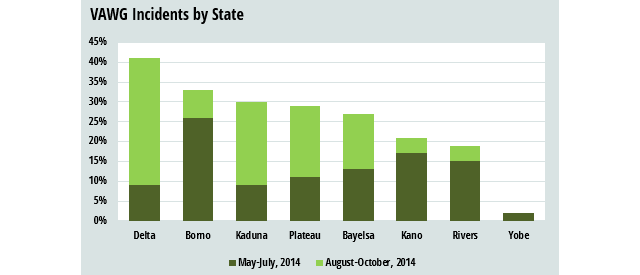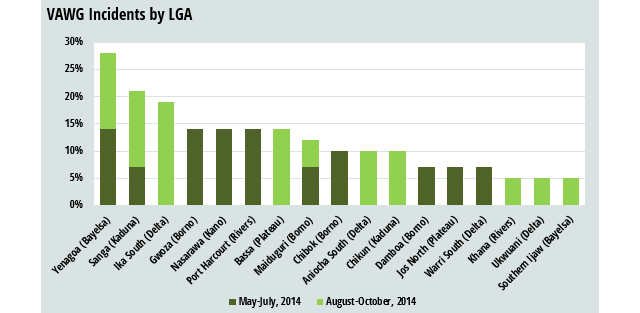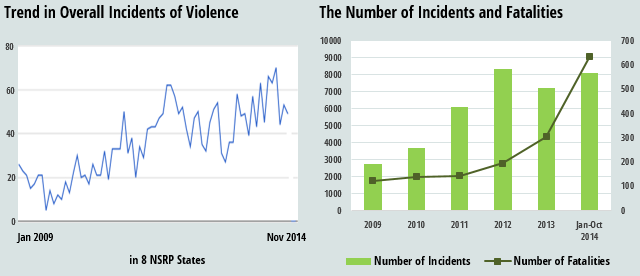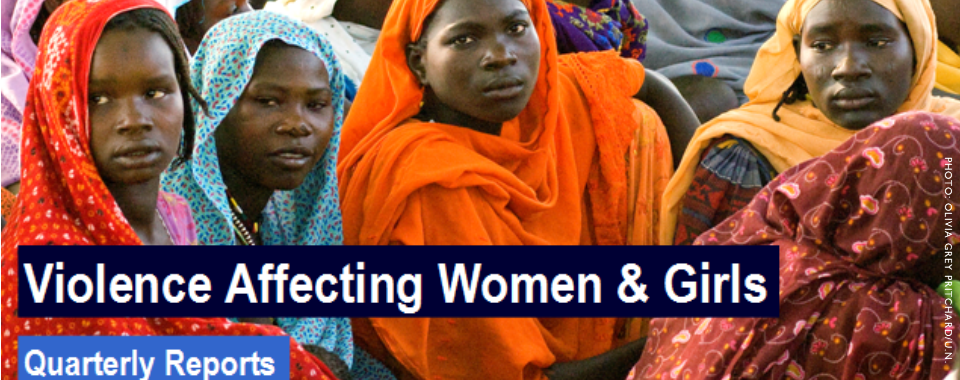BY PATRICIA TAFT*
The following report summarizes the main findings as detailed in three memos, produced during the second quarter of data collection and analysis. Because this project began mid-year (the first monthly memo covered the month of May, and the first Quarterly Report covered the months of May-July) this second Quarterly Report covers the time period of August through October 2014.
In terms of overall violence, if current trends continue, 2014 is on track to be the worst year since 2009, as measured by both the number of incidents and fatalities. Already it is by far the worst as measured by the number of fatalities. Findings tend to vary, however, by state and by time period, with the Northeast still the most violent region, led by Borno State.
With regards to VAWG, the same deterioration can be seen on an annualized basis, with Delta state having the most incidents reported overall and Yobe, the least. The states which have shown the most worsening in the last three years are Borno, Kano, and Plateau states. Also, as noted in previous memos, the root causes of violence tends to differ by region. In Delta and Rivers, VAWG incidents often occur within the context of domestic, criminal and cult violence, with women being both targets as well as innocent bystanders swept up in the general insecurity. Particularly in Delta State, incidents of domestic abuse dominated, although there were also several instances of kidnapping and abductions perpetrated against female family members of high ranking political or community leaders. In the Northeast, VAWG tends to occur in the context of the insurgency and counter-insurgency, especially in Borno State where JAS continues to be active and the kidnapping of girls is rampant. In the North Central region, VAWG issues related to forced marriages and communal violence tended to dominate, with incidents of rape, particularly of young girls, prevalent in Kano. In the Middle Belt, incidents of VAWG were also frequently related to communal violence, with women and girls caught up in various conflicts between groups that included the destruction of homes and businesses. Women were often the target reprisal attacks over perceived injustices related to land and livestock.
There are now 46 self-identified Agents of Peace, broken out by LGA, focusing on issues of gender in the NSRP states. This is a net increase of 8 from the previous quarterly report.
Trends
Data compiled on the Observatory Platform suggests that both VAWG as well as overall violence and conflict risk continues to worsen in the eight NSRP states, with the month of July being the worst since January 2009.
With regards specifically to VAWG, deterioration can be seen on an annualized basis with over 60 reported incidents so far this year by Nigeria Watch, making 2014 the worst year yet since 2009. The state with the highest number of reported VAWG incidents during the period of August-October 2014 was Delta. The lowest number of reports was in Yobe. At the LGA level, Ika South, Delta State had the highest percentage of VAWG related incidents, followed by Yenagoa LGA in Bayelsa, Bassa LGA in Plateau, and Sanga LGA in Kaduna (see graphs below).

Figure 1: Stacked Area Chart showing Trend in VAWG Incidents Reported by NSRP State, Nigeria Watch data (larger area=more incidents)

Figure 2: VAWG Incidents by state as a percentage of the total number of VAWG incidents in the respective period. Graph shows that the preponderance of reports in the second period were in Delta, which was a change from the first period when Borno was the epicenter of reported VAWG incidents.

Figure 3: VAWG Incidents by top 17 LGAs as a percentage of the total number of VAWG incidents in the respective period. Graph shows that while at the state level the preponderance of reports were in Delta, at the LGA level, most reports were reported in Yenagoa, Bayelsa State.
May-July, 2014 August-October, 2014

Figure 4: Observatory Screenshot (ACLED and Nigeria Watch) – http://www.nsrp-nigeria.org/
Specific Findings in the Eight NSRP Target States (August-October 2014)
This summary report focuses on the NSRP’s eight target states during the time period August through October 2014. During this time period, reported violence affecting women and girls has continued to rise, putting 2014 well on track to be the most violent year since we began tracking in 2009. After a spike in the number of incidents in July, surrounding a spate of suicide bombings in Kano State, numbers dropped off again in August and September. In October, however, the number of incidents rose again surrounding the kidnapping of dozens of girls in attacks on schools in the village of Mafa. During these attacks, it was reported that up to 17 people were killed, including boys and girls. In Yobe, there were no reported incidents during this quarter although much of this may have to do with limited access to information and reporting due to the State of Emergency and the overall security situation. In order to achieve the maximum coverage for this region, reports from Peace Agents or other local sources will need to be sought out more creatively.
Other incidents of note during the time period examined include the continued prevalence of communal violence as the underlying conflict driver in both Plateau and Kaduna states. In Plateau in September, it was reported that suspected herdsmen launched a reprisal attack on a community in Bokkos LGA, resulting in the death of a woman and her two children. This appeared to be one in a series of ongoing intercommunal attacks and reprisals. In Kaduna, an August attack on a Gimi community in Sanga LGA resulted in the deaths of at least one woman and the maiming of a young baby girl, also seemingly part of a larger pattern of intercommunal violence characterized by attacks and counter-attacks between communities. In Bayelsa, the number of incidents generally decreased from previous months with no reported incidents of VAWG in August and September and three cases in October, the main being tied to a larger, offshore, kidnapping attempt. Other issues that continued or grew worse were the prevalence of criminal and domestic violence in relation to VAWG in Delta State. Of note, in October it was reported that at least 33 children were freed in a police raid on an illegal orphanage engaged in child tracking. In Rivers, as in the prior quarter, cult and gang-related violence continued to be the main driver of VAWG-related incidents, with women and children often caught in the crossfire or direct victims of kidnapping.
Finally, as noted above, Borno State continued to see continued high levels of violence as it pertains to women and girls, particularly around the JAS insurgency. Another trend that arose during the quarter was an increase in VAWG in Borno in relation to communal violence, as well as a spike in the number of reports of incest and child defilement. By October, however, the JAS insurgency and its deadly toll on women and girls once again came to the forefront as at least 30 children were kidnapped and others killed in attacks on Mafa LGA.
Overall Incidents and VAWG (August-October 2014)
As evidenced below, violence appears to be worsening in NSRP’s eight focus states. Likewise, reporting of violence affecting women and girls is also increasing in media reports and in participatory conflict assessment forums involving local stakeholders.
Trend in Overall Incidents of Violence in 8 NSRP States

Figure 5: Monthly trend in Overall Incidents of Violence in Eight NSRP States, Nigeria Watch Data mapped to Observatory Platform
* Kendall Lawrence and Hannah Blyth contributed to this report.
